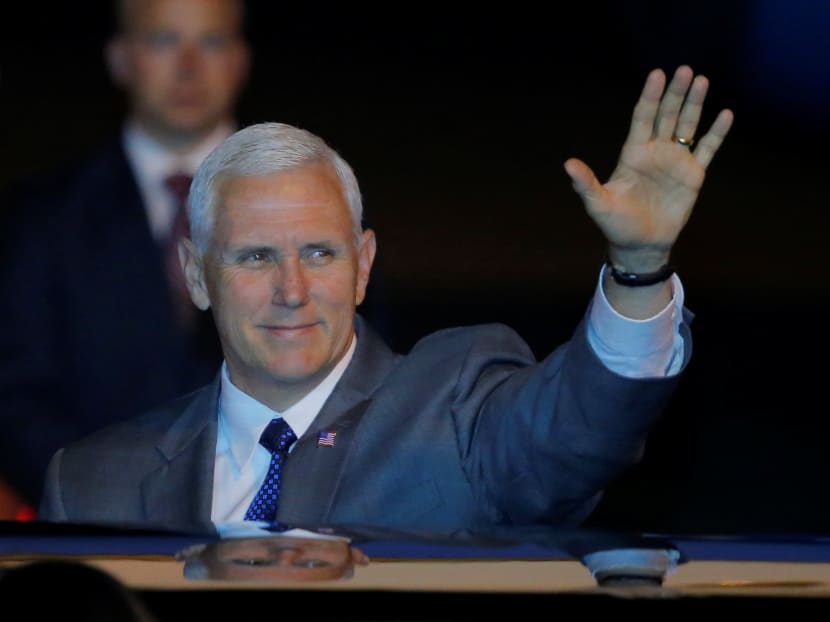In wake of tense Trump call, Pence aims to sooth Australia
SYDNEY — More than two months after United States President Donald Trump got into a spat with the leader of Australia, Vice President Mike Pence will be working to smooth over any lingering hard feelings.

American Vice President Mike Pence waves as he arrives at Sydney International Airport in Australia, April 21, 2017. Source: Reuters
SYDNEY — More than two months after United States President Donald Trump got into a spat with the leader of Australia, Vice President Mike Pence will be working to smooth over any lingering hard feelings.
Mr Pence will meet with Australian Prime Minister Malcolm Turnbull on Saturday (April 22) in the final leg of his 10-day, four-country trip to the Asia Pacific. His agenda includes reassuring Mr Turnbull about the state of the unusually strained US-Australia alliance and laying out the new administration’s priorities for the Pacific Rim.
“Partly, you could call it a diplomatic clean-up mission,’’ said Mr Michael Auslin of the American Enterprise Institute, an analyst on Asian security issues. Mr Auslin said Mr Pence will be more focussed on offering Mr Turnbull a roadmap for how the two countries can work together during Mr Trump’s presidency. “It’s about re-establishing relations.”
The affection the longtime allies usually share for each other is rooted in decades of cooperation on defence, intelligence and trade. Australia has fought alongside the US in every major conflict since World War I, and is one of the largest contributors to the US-led military campaign in Iraq and Syria. The country is also part of the “Five Eyes” intelligence-sharing programme with the US, along with Canada, Britain and New Zealand.
But Australia was unhappy with Mr Trump’s decision to pull the US out of the 12-nation Trans-Pacific Partnership trade pact. Then, Mr Trump and Mr Turnbull had a contentious phone call in January over a refugee resettlement deal struck by the previous Obama administration.
Under the agreement, the US would take up to 1,250 refugees that Australia houses in detention camps on the Pacific island nations of Nauru and Papua New Guinea. Mr Trump, who campaigned on tough-on-immigration policies, was enraged by the agreement, prompting a tense phone call with Mr Turnbull and an angry tweet in which the president dubbed the deal “dumb”.
White House spokesman Sean Spicer’s subsequent mispronunciation in press briefings of Mr Turnbull’s name as “Trumbull” did not help matters.
The fallout has left relations between the US and Australia at their lowest point since the Vietnam War, when Australia’s then-Prime Minister Gough Whitlam criticised a series of bombings authorised by then-President Richard Nixon.
Mr Dougal Robinson, a research fellow with the US Studies Centre in Sydney, said the timing of Mr Pence’s visit to Australia - a mere three months into Mr Trump’s presidency - is significant. Mr Robinson noted that it took former president Barack Obama three years to visit Australia after he was elected, while former Vice President Joe Biden waited seven years before traveling Down Under.
“In the aftermath of the Trump-Turnbull phone call, and no record of any conversation between the president and the prime minister since that phone call, the vice president is clearly coming to try to reassure Australia’s political leaders about US commitment to the alliance with Australia,” Mr Robinson said.
Mr Trump’s election has also prompted some soul-searching for Australians over where their loyalty should lie between the US - Australia’s most important security partner - and China - its most important trading partner. Though Mr Turnbull has repeatedly rejected calls for Australia to choose between the economic superpowers, some critics of Mr Trump have urged Australia to align itself more closely with Beijing.
Earlier this month, Mr Gareth Evans, Australia’s foreign minister from 1988 to 1996, said Australia should back away from its alliance with America and instead recognise China as a global leader, calling Mr Trump “the most ill-informed, under prepared, ethically challenged and psychologically ill-equipped president in the United States’ history.”
Though Mr Turnbull may balk at publicly choosing between China and the US, Australia and China have indeed been deepening their ties. In February, Chinese Foreign Minister Wang Yi met with Australian Foreign Minister Julie Bishop in the nation’s capital, Canberra, where the two announced they would cooperate more on trade, tourism, regional infrastructure, innovation and energy.
The strengthening commercial relationship between China and Australia has raised eyebrows in the US. Australia’s decision to allow a Chinese company to secure a 99-year lease over the strategically important Port of Darwin in northern Australia attracted particular concern. The port is near a critical military base used as a training hub for US Marines, who are stationed there as part of America’s military pivot to Asia.
The South China Sea, where China’s territorial claims, land reclamation and construction have drawn criticism from its neighbours and the US, is also likely to factor in talks between Mr Pence and Mr Turnbull.
Given Australia’s loyalty to both the US and China, the country has tried to avoid taking sides in the conflict. Though Australia has long supported America’s so-called freedom of navigation exercises close to China’s artificial islands in the region, it has not conducted any of its own.
In March, Ms Bishop urged the Association of South-east Asian Nations (Asean) and China to put in place a legally binding code of conduct on behaviour in the South China Sea.
Mr Pence, addressing sailors aboard the USS Ronald Reagan in Japan earlier this week, said the administration would “protect the freedom of navigation and overflight and other lawful uses of the sea, in the South China Sea and elsewhere.
Mr Pence will meet with Ms Bishop during his trip to Australia. He is also scheduled to meet with Governor-General Peter Cosgrove and local business leaders, before touring Sydney’s iconic Opera House and visiting the city’s harbourside zoo. AP






